I have always heard chatter about 1980’s MIJ Strats. About a year ago I finally decided to see for myself why they are spoke of so highly by many. I have done tons of research on fender Japan and have learned quite a lot and now know why that particular time (1980’s) is significant regarding Fender Japan. I’m not going to get into the history but if you are curious, feel free to ask and hopefully I have an answer for you.
Back to my point, about a year ago I bought my first MIJ Strat, a mid 80’s Squier 
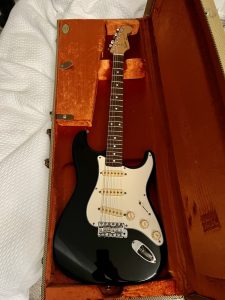
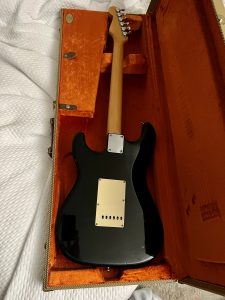
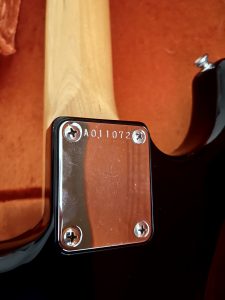
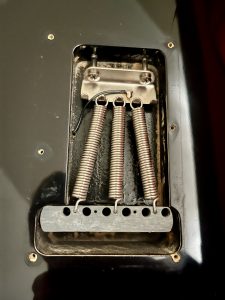
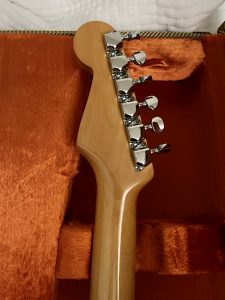
for some reason a previous owner decided to scratch off the “made in Japan” on the headstock.
And a gut shot below… nothing fancy or special here, but I was pleasantly surprised to see full size pots.
This guitar features the following: most likely a basswood body, small vintage frets, 7.25 radius rosewood fretboard, maple neck with no skunk stripe, with the truss rod adjustment at the heel of the neck. For the most part it’s a fairly vintage spec’d strat. The pickups are low output ceramic pickups unlike the hot MIM ceramic Strat pickups. These pickups are very “stratty” if you will and are not a “need” to be swapped item. However, some will say otherwise solely based on the fact that they’re ceramic. Of course there are better pickup options i could put in this guitar, but these are tonally different than my other Strats and I like them. The neck feels amazing and I have since been hooked on MIJ strats. So much so that I sold a my MIA strat to fund my new obsession with MIJ strats.
I have since acquired four more! Including this one: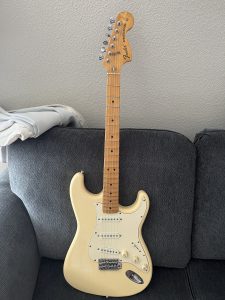
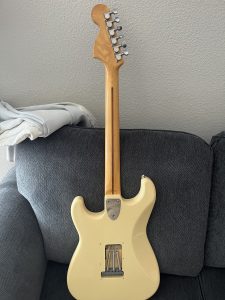
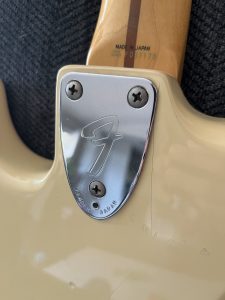
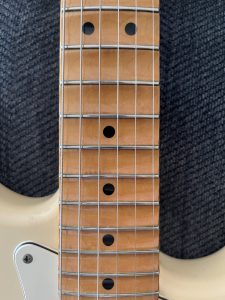
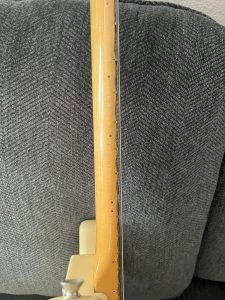
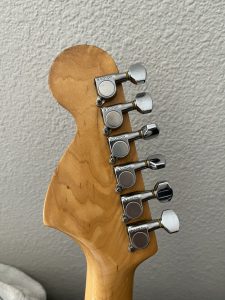
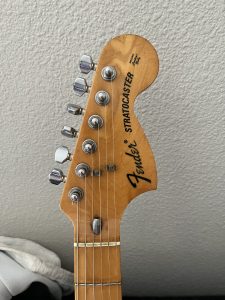
Based on the SN# this is a 1986-89 MIJ strat. It’s some sort of Yngwie Malmsteen inspired model that predates the actually signature models. Amazing guitar with some interesting features such as a three bolt neck with a bullet truss rod like you’d find on a 70’s Strat, a 10” radius fretboard that is scalloped from the factory, and the lovely large head stock.
My playing is very much rooted in the blues and I never thought I’d play a scalloped fretboard, but I love this guitar and with a light touch it’s a pretty seamless transition, and this guitar is set up with 8’s which is lighter than I’m use to playing. Although some may think having a scalloped fretboard will make you play faster, sadly it’s not the case, but they do give more control when bending. So if you are like me and have avoided scalloped boards like the plague, I say try one if you get a chance. You never know, you might like it. I’m not going to go and scallop my other fretboards but I do like it and will keep this one as is.
Recently I swapped all the electronics on this guitar to be more in line with 60’s specs with a .1mfd ceramic disc cap and put in a set of Fender pure vintage ‘65 pickups. I had no issue with the original setup, just wanted to try something different.
Here’s some specs I found on an online forum that pretty much describe this guitar exactly. (Although all the specs seem to line up, I cannot say for certain that it’s the model described below but to the best of my knowledge I believe it is.)
“ST72-95SC 1986-1987
This is the earliest SC Model I have found anywhere, Legitimate FXXXXXX Serial #
Body Material/Finish: Basswood, poly finish on body, CST-50 only made in 1983
Neck: Large CBS style head stock 10″ radius, large logo, 3 bolt micro-tilt, amber tinted
Scallops/Frets: Uneven scallop job, not centered, deeper on treble side, some frets not scalloped at all on bass side, scallop looks like a swoosh like the Blackmore model, small frets
Tuners/String Tree(s): Gotoh, two string trees
Truss Rod/Nut: Bullet with access from head stock, plastic nut
Pickups/Pickup Selector: Japan ST, 5 way MIJ selector
Pickguard/Back Plate: White 3 ply pick guard, single ply 6 hole back plate
Pots: CTS, modern wiring
Bridge: MIJ diecast block and saddles
Serial # Location: Back of the neck, low, near where it meets the body
Weight: 7lb 11oz
Colors: Black, yellow white”
This next MIJ Strat is what I believe to be a 1985 Contemporary Strat with system 1 tremolo, which is missing the locking system behind the nut and the fine tuners on the bridge.
Features: maple neck, medium jumbo frets, 12” radius rosewood fretboard, most likely a basswood body, and vintage style MIJ alnico V pickups, and a five way selector switch. However, the neck pickup does not appear stock and I’ve yet to take the pickguard off to see what it is, but it sounds great. It has been modified by a previous owner with a blend mod which consist of a master volume, master tone, and a blend knob to blend the neck pickup to taste with the other positions. For variety of tones, this on takes the cake. This guitar sings even when unplugged and plays like a dream. Some photos: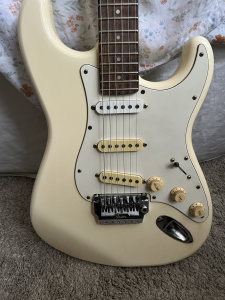
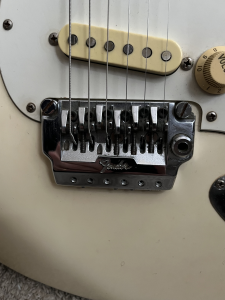
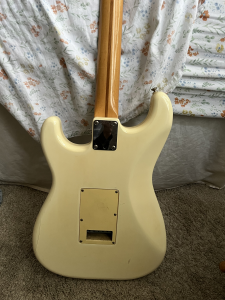
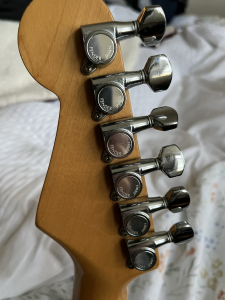
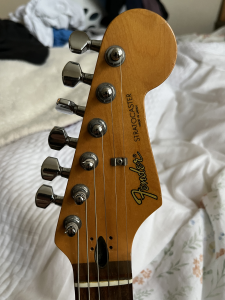
I loved it so much, as soon a another by one came up for sale locally, I couldn’t resist… so now I have a black one too and the guy I got it from had owned it since the 80’s. All original! Pictured below: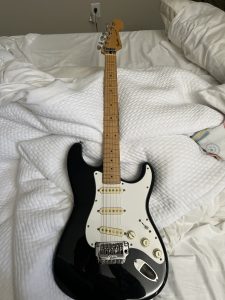
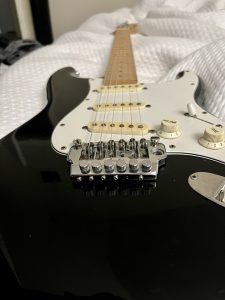
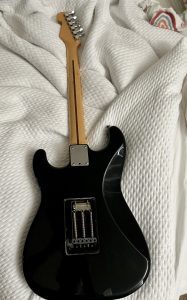
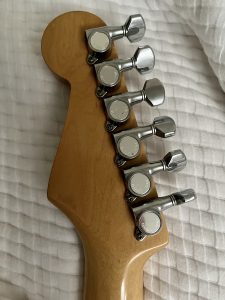
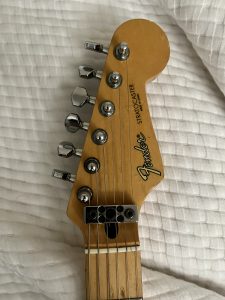
And I didn’t stop there.. I also acquired what’s most well known as an “E series” Squier, which I have pictured below. 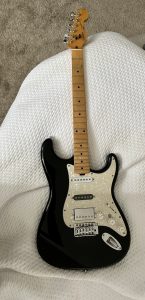
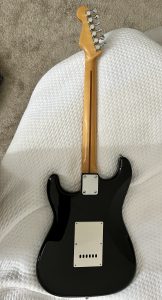
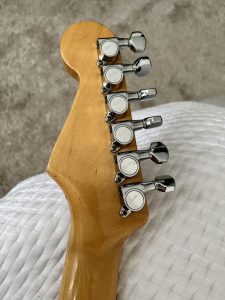
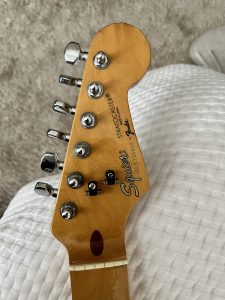
If you’ve ever looked into 80’s era MIJ Strats you’ll hear people go on and on about “E series” Strats. Just to clarify, thats is just how most people refer the Strats that have a serial number that begins with the letter “E”. Many people say the first number in the serial number indicates the year manufactured. For example E7 = 1987, E6 = 1986. However, to my knowledge that is no more than and assumption and has no factual basis. Furthermore, there are sources that say “E” serial number strats range from 1984-1987 and others that say 1984-1989. It appears that there was a lack of documentation/record keeping on Fender Japan’s part throughout this era which has led many to fill in the blanks on their own, which has resulted in a lot of misinformation being spread on these guitars. I do try my best to not be a part of the problem, which is why almost every bit of information I have provided in this post is not presented as hard facts, merely conclusions I’ve made to the best of my knowledge based on the research I’ve done. The only thing I’m 100% certain of is my impression of these guitars and I love them.
Something to look out for if you are in the market for an 80s MIJ Strat is that you will see some sellers putting heavy emphasis on the E serial number guitars and listing them at a higher price point than other fenders from that era. In regards to that I will say that of the five MIJ Strats I own from that era (although a very small sample size), four of them do not have an “E” in the serial number, and I think they are all great guitars, so I personally would not spend a penny more on a guitar solely because the seller thinks it’s special because it’s an “E Series”.
OK sorry for the long rant. Now to the info on the guitar. It was sold to me as a 1986 MIJ Squire. Maple neck, Maple fretboard, Feels like medium jumbo frets and I haven’t measured the fretboard radius but I think its 12”. It has Fender marked Gotoh tuners and the truss rod adjustment is at the heel of the neck. I have no clue what wood the body is but it’s the lightest of the bunch. this is one of those guitars that definitely seems its been around the block a few times before getting to me. It’s been well played and that is usually a sign of a good guitar.
from what I can tell, none of the electronics are original. Both single coils have been changed and a humbucker was put in the bridge position. it also has 500k pots. Well at least the volume pot is 500k, because on this guitar, having the tone at about 2 is the equivalent of having the tone on 10 on a typical strat with 250k pots. It’s has one tone pot wired to the neck/middle and the other tone to the Bridge humbucker. It also has a switch to split the coils on the humbucker. It’s sounds good and different for sure from my others. It’s can achieve very bright, spanky tones that no other guitar I own or have played can achieve. It gets overly bright real fast if you’re not careful, but with a darker rig it might be just what you need. The neck feels great and it plays great which is why I bought it. Also it was local and cheap!
However, there are some details about this guitar seem a bit off. The first thing I noticed was that the bridge is not consistent with those i have seems on other models from this era. To me, it appears like something that would’ve been used on low price, entry-level model, and I am unsure whether or not this bridge was ever used on the Fender Japan guitars in this era. Second thing I noticed, is that the cover for the cavity on the back of the guitar did not look right. The center screw holes on either side of the cover are in line with each other rather than being offset. The third thing was that the neck did not fit in the neck pocket like my other MIJ’s. My others fit great but this one seems like the pocket is a little big for the neck. So this very well could be some other strat body (possibly Korean) with an MIJ neck. When I need to take the neck off I’ll check for marking and hopefully get some answers. Really makes no difference to me, this guitar feels great to play and sounds great too.
So after all this I have found that Fender Japan made some amazing guitars and their quality control seems to be as good as they say. Although I’ve only played the few that I own, they are hands down among the best strats I’ve played and I’ve yet to come across a dud and I don’t see myself forking out the cash for a MIA Strat anytime soon. But price aside, in my opinion these are great and in addition to the sound and amazingly comfortable necks, they have a special character about them that makes them keepers in my book. I’m happy to answer any questions about the guitars.
So what is your experience or opinion on MIJ strats?
Like them?
Love them?
Hate them?
Or obsessed with them like I clearly am.
I hope this will spark a conversation and generate some input from those of you who have knowledge about these guitars (likely much more than I) and provide a good resource for those who are curious or potentially in the market for a MIJ guitar.
Thanks for reading.
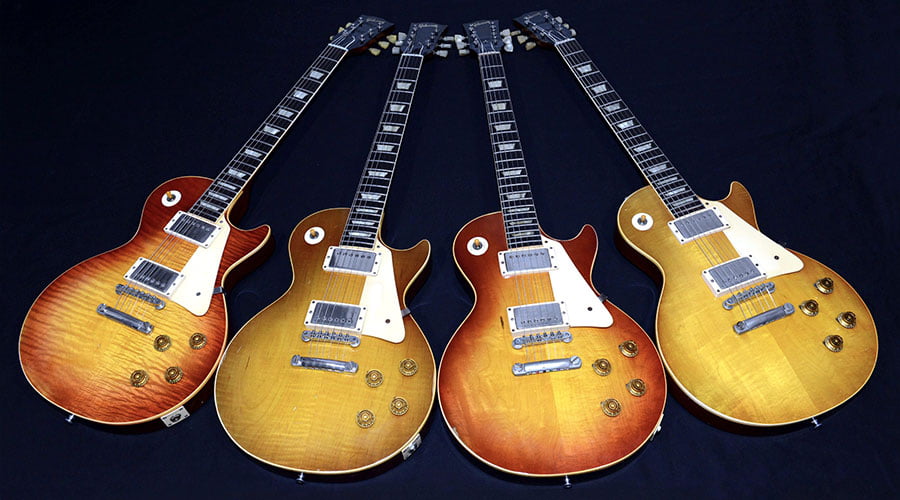
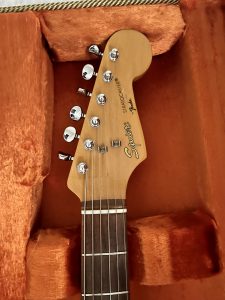
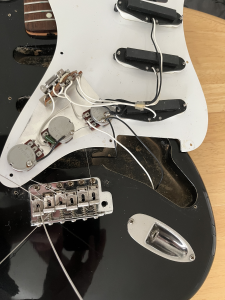
Leave a Reply